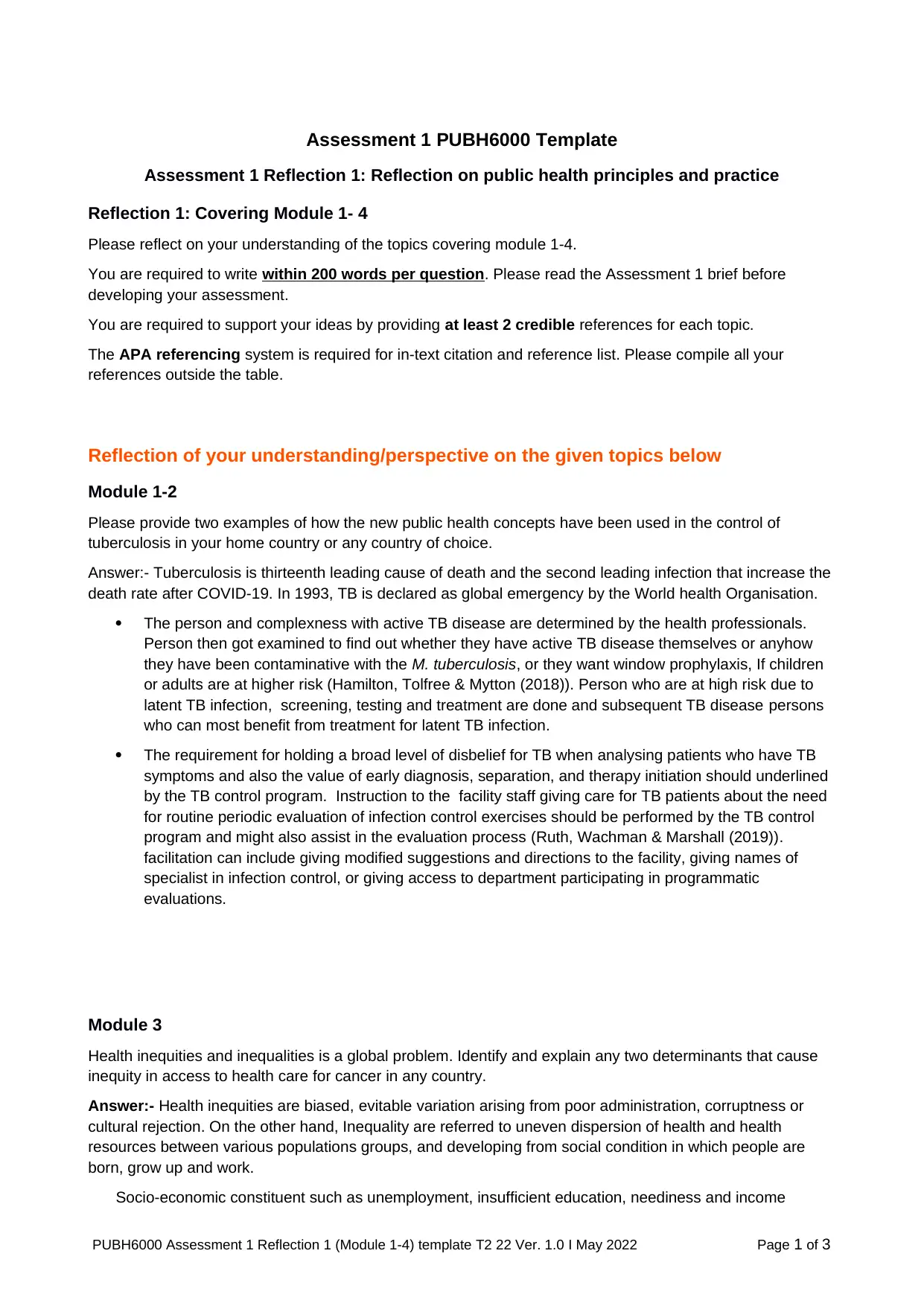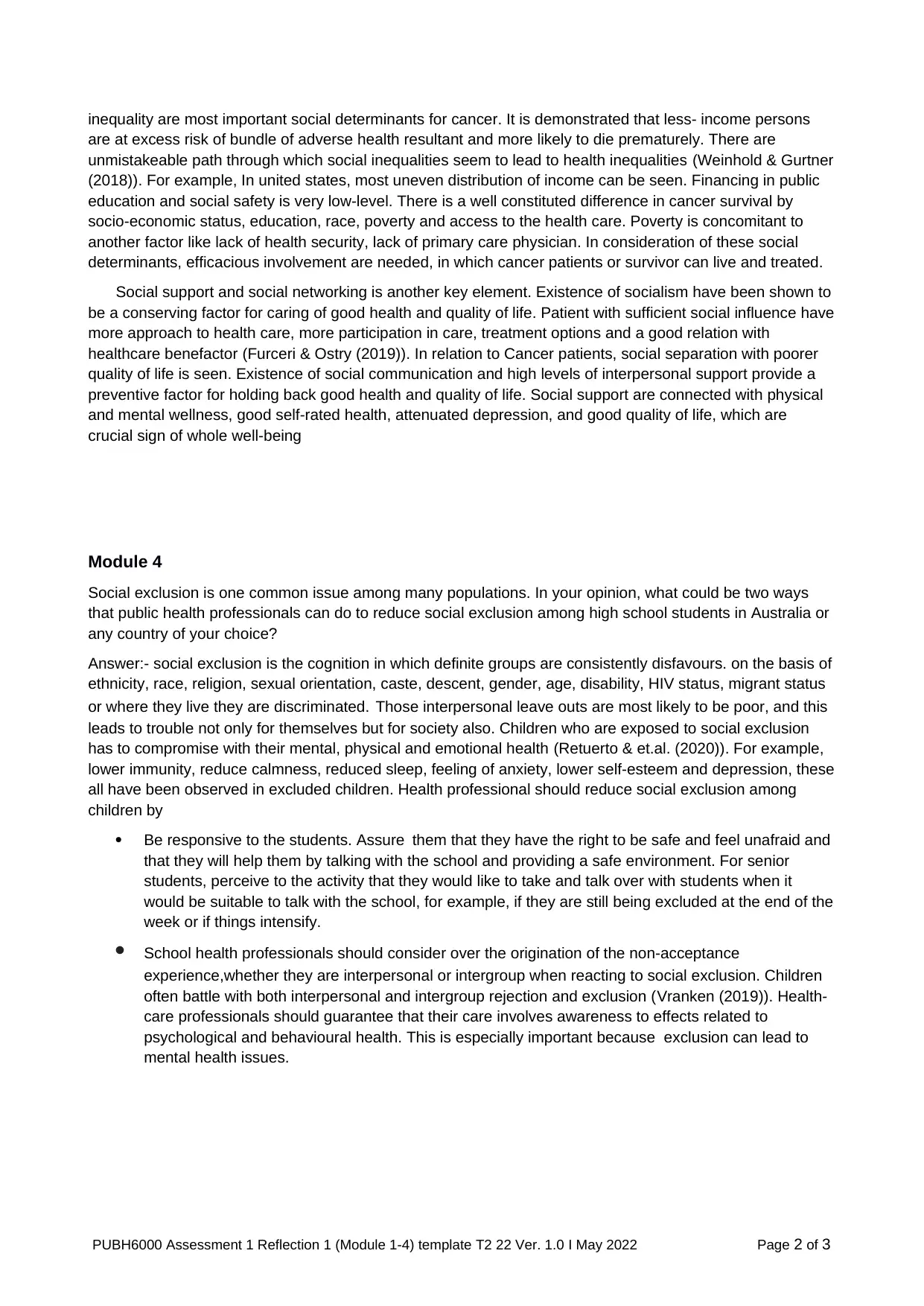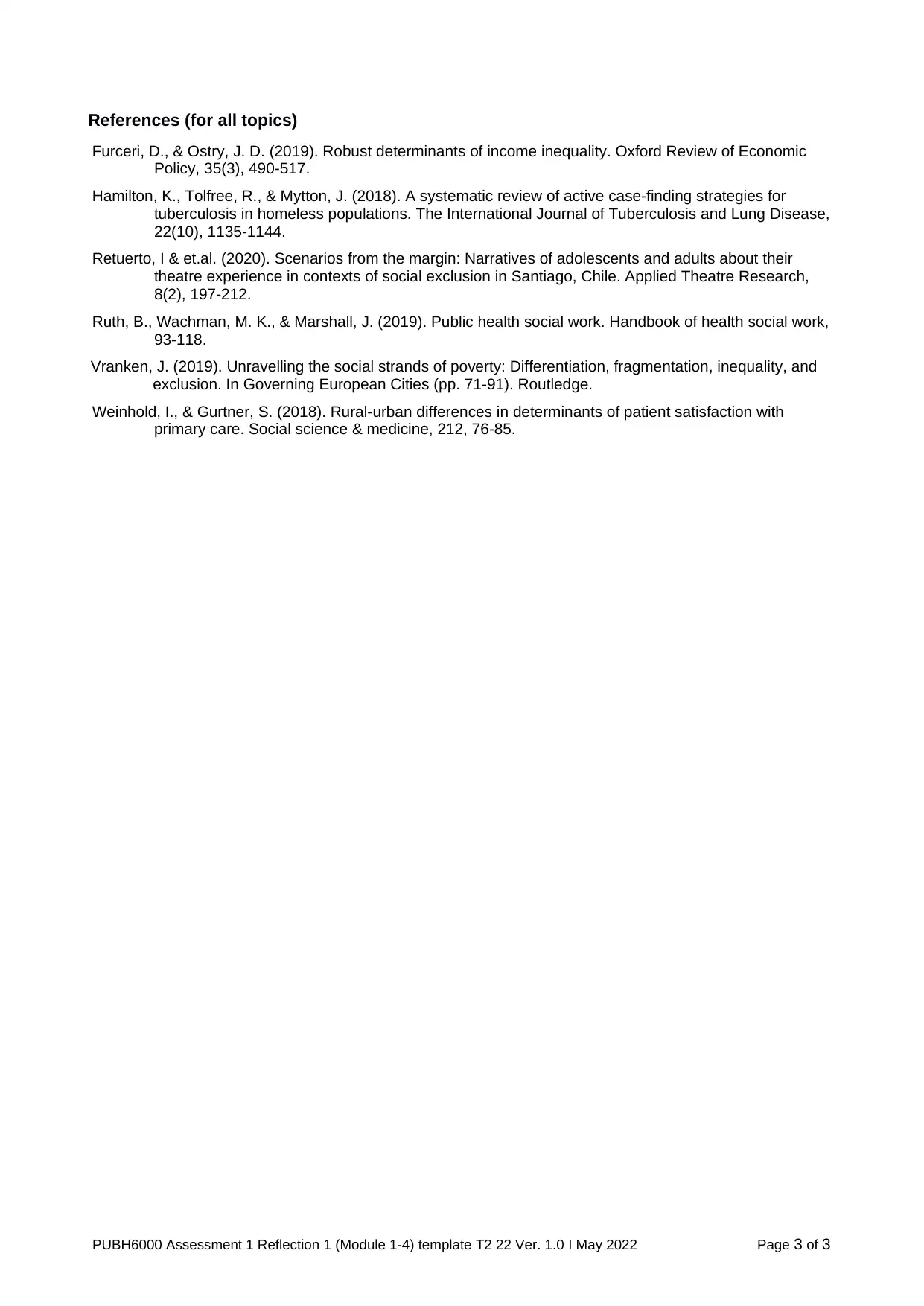PUBH6000 Assessment 1: Reflection on Public Health Principles
VerifiedAdded on 2023/06/08
|3
|1423
|65
Homework Assignment
AI Summary
This assignment is a reflection on public health principles and practices, covering modules 1-4 of a PUBH6000 course. The student explores two examples of how new public health concepts have been used in controlling tuberculosis, identifies and explains determinants causing inequity in cancer care access, and proposes two ways public health professionals can reduce social exclusion among high school students. The reflection is supported by credible references and follows APA referencing guidelines. The assignment addresses key public health issues such as infectious disease control, health disparities, and social determinants of health, providing insights into practical applications of public health concepts.

Assessment 1 PUBH6000 Template
Assessment 1 Reflection 1: Reflection on public health principles and practice
Reflection 1: Covering Module 1- 4
Please reflect on your understanding of the topics covering module 1-4.
You are required to write within 200 words per question. Please read the Assessment 1 brief before
developing your assessment.
You are required to support your ideas by providing at least 2 credible references for each topic.
The APA referencing system is required for in-text citation and reference list. Please compile all your
references outside the table.
Reflection of your understanding/perspective on the given topics below
Module 1-2
Please provide two examples of how the new public health concepts have been used in the control of
tuberculosis in your home country or any country of choice.
Answer:- Tuberculosis is thirteenth leading cause of death and the second leading infection that increase the
death rate after COVID-19. In 1993, TB is declared as global emergency by the World health Organisation.
The person and complexness with active TB disease are determined by the health professionals.
Person then got examined to find out whether they have active TB disease themselves or anyhow
they have been contaminative with the M. tuberculosis, or they want window prophylaxis, If children
or adults are at higher risk (Hamilton, Tolfree & Mytton (2018)). Person who are at high risk due to
latent TB infection, screening, testing and treatment are done and subsequent TB disease persons
who can most benefit from treatment for latent TB infection.
The requirement for holding a broad level of disbelief for TB when analysing patients who have TB
symptoms and also the value of early diagnosis, separation, and therapy initiation should underlined
by the TB control program. Instruction to the facility staff giving care for TB patients about the need
for routine periodic evaluation of infection control exercises should be performed by the TB control
program and might also assist in the evaluation process (Ruth, Wachman & Marshall (2019)).
facilitation can include giving modified suggestions and directions to the facility, giving names of
specialist in infection control, or giving access to department participating in programmatic
evaluations.
Module 3
Health inequities and inequalities is a global problem. Identify and explain any two determinants that cause
inequity in access to health care for cancer in any country.
Answer:- Health inequities are biased, evitable variation arising from poor administration, corruptness or
cultural rejection. On the other hand, Inequality are referred to uneven dispersion of health and health
resources between various populations groups, and developing from social condition in which people are
born, grow up and work.
Socio-economic constituent such as unemployment, insufficient education, neediness and income
PUBH6000 Assessment 1 Reflection 1 (Module 1-4) template T2 22 Ver. 1.0 Ι May 2022 Page 1 of 3
Assessment 1 Reflection 1: Reflection on public health principles and practice
Reflection 1: Covering Module 1- 4
Please reflect on your understanding of the topics covering module 1-4.
You are required to write within 200 words per question. Please read the Assessment 1 brief before
developing your assessment.
You are required to support your ideas by providing at least 2 credible references for each topic.
The APA referencing system is required for in-text citation and reference list. Please compile all your
references outside the table.
Reflection of your understanding/perspective on the given topics below
Module 1-2
Please provide two examples of how the new public health concepts have been used in the control of
tuberculosis in your home country or any country of choice.
Answer:- Tuberculosis is thirteenth leading cause of death and the second leading infection that increase the
death rate after COVID-19. In 1993, TB is declared as global emergency by the World health Organisation.
The person and complexness with active TB disease are determined by the health professionals.
Person then got examined to find out whether they have active TB disease themselves or anyhow
they have been contaminative with the M. tuberculosis, or they want window prophylaxis, If children
or adults are at higher risk (Hamilton, Tolfree & Mytton (2018)). Person who are at high risk due to
latent TB infection, screening, testing and treatment are done and subsequent TB disease persons
who can most benefit from treatment for latent TB infection.
The requirement for holding a broad level of disbelief for TB when analysing patients who have TB
symptoms and also the value of early diagnosis, separation, and therapy initiation should underlined
by the TB control program. Instruction to the facility staff giving care for TB patients about the need
for routine periodic evaluation of infection control exercises should be performed by the TB control
program and might also assist in the evaluation process (Ruth, Wachman & Marshall (2019)).
facilitation can include giving modified suggestions and directions to the facility, giving names of
specialist in infection control, or giving access to department participating in programmatic
evaluations.
Module 3
Health inequities and inequalities is a global problem. Identify and explain any two determinants that cause
inequity in access to health care for cancer in any country.
Answer:- Health inequities are biased, evitable variation arising from poor administration, corruptness or
cultural rejection. On the other hand, Inequality are referred to uneven dispersion of health and health
resources between various populations groups, and developing from social condition in which people are
born, grow up and work.
Socio-economic constituent such as unemployment, insufficient education, neediness and income
PUBH6000 Assessment 1 Reflection 1 (Module 1-4) template T2 22 Ver. 1.0 Ι May 2022 Page 1 of 3
Paraphrase This Document
Need a fresh take? Get an instant paraphrase of this document with our AI Paraphraser

inequality are most important social determinants for cancer. It is demonstrated that less- income persons
are at excess risk of bundle of adverse health resultant and more likely to die prematurely. There are
unmistakeable path through which social inequalities seem to lead to health inequalities (Weinhold & Gurtner
(2018)). For example, In united states, most uneven distribution of income can be seen. Financing in public
education and social safety is very low-level. There is a well constituted difference in cancer survival by
socio-economic status, education, race, poverty and access to the health care. Poverty is concomitant to
another factor like lack of health security, lack of primary care physician. In consideration of these social
determinants, efficacious involvement are needed, in which cancer patients or survivor can live and treated.
Social support and social networking is another key element. Existence of socialism have been shown to
be a conserving factor for caring of good health and quality of life. Patient with sufficient social influence have
more approach to health care, more participation in care, treatment options and a good relation with
healthcare benefactor (Furceri & Ostry (2019)). In relation to Cancer patients, social separation with poorer
quality of life is seen. Existence of social communication and high levels of interpersonal support provide a
preventive factor for holding back good health and quality of life. Social support are connected with physical
and mental wellness, good self-rated health, attenuated depression, and good quality of life, which are
crucial sign of whole well-being
Module 4
Social exclusion is one common issue among many populations. In your opinion, what could be two ways
that public health professionals can do to reduce social exclusion among high school students in Australia or
any country of your choice?
Answer:- social exclusion is the cognition in which definite groups are consistently disfavours. on the basis of
ethnicity, race, religion, sexual orientation, caste, descent, gender, age, disability, HIV status, migrant status
or where they live they are discriminated. Those interpersonal leave outs are most likely to be poor, and this
leads to trouble not only for themselves but for society also. Children who are exposed to social exclusion
has to compromise with their mental, physical and emotional health (Retuerto & et.al. (2020)). For example,
lower immunity, reduce calmness, reduced sleep, feeling of anxiety, lower self-esteem and depression, these
all have been observed in excluded children. Health professional should reduce social exclusion among
children by
Be responsive to the students. Assure them that they have the right to be safe and feel unafraid and
that they will help them by talking with the school and providing a safe environment. For senior
students, perceive to the activity that they would like to take and talk over with students when it
would be suitable to talk with the school, for example, if they are still being excluded at the end of the
week or if things intensify.
School health professionals should consider over the origination of the non-acceptance
experience,whether they are interpersonal or intergroup when reacting to social exclusion. Children
often battle with both interpersonal and intergroup rejection and exclusion (Vranken (2019)). Health-
care professionals should guarantee that their care involves awareness to effects related to
psychological and behavioural health. This is especially important because exclusion can lead to
mental health issues.
PUBH6000 Assessment 1 Reflection 1 (Module 1-4) template T2 22 Ver. 1.0 Ι May 2022 Page 2 of 3
are at excess risk of bundle of adverse health resultant and more likely to die prematurely. There are
unmistakeable path through which social inequalities seem to lead to health inequalities (Weinhold & Gurtner
(2018)). For example, In united states, most uneven distribution of income can be seen. Financing in public
education and social safety is very low-level. There is a well constituted difference in cancer survival by
socio-economic status, education, race, poverty and access to the health care. Poverty is concomitant to
another factor like lack of health security, lack of primary care physician. In consideration of these social
determinants, efficacious involvement are needed, in which cancer patients or survivor can live and treated.
Social support and social networking is another key element. Existence of socialism have been shown to
be a conserving factor for caring of good health and quality of life. Patient with sufficient social influence have
more approach to health care, more participation in care, treatment options and a good relation with
healthcare benefactor (Furceri & Ostry (2019)). In relation to Cancer patients, social separation with poorer
quality of life is seen. Existence of social communication and high levels of interpersonal support provide a
preventive factor for holding back good health and quality of life. Social support are connected with physical
and mental wellness, good self-rated health, attenuated depression, and good quality of life, which are
crucial sign of whole well-being
Module 4
Social exclusion is one common issue among many populations. In your opinion, what could be two ways
that public health professionals can do to reduce social exclusion among high school students in Australia or
any country of your choice?
Answer:- social exclusion is the cognition in which definite groups are consistently disfavours. on the basis of
ethnicity, race, religion, sexual orientation, caste, descent, gender, age, disability, HIV status, migrant status
or where they live they are discriminated. Those interpersonal leave outs are most likely to be poor, and this
leads to trouble not only for themselves but for society also. Children who are exposed to social exclusion
has to compromise with their mental, physical and emotional health (Retuerto & et.al. (2020)). For example,
lower immunity, reduce calmness, reduced sleep, feeling of anxiety, lower self-esteem and depression, these
all have been observed in excluded children. Health professional should reduce social exclusion among
children by
Be responsive to the students. Assure them that they have the right to be safe and feel unafraid and
that they will help them by talking with the school and providing a safe environment. For senior
students, perceive to the activity that they would like to take and talk over with students when it
would be suitable to talk with the school, for example, if they are still being excluded at the end of the
week or if things intensify.
School health professionals should consider over the origination of the non-acceptance
experience,whether they are interpersonal or intergroup when reacting to social exclusion. Children
often battle with both interpersonal and intergroup rejection and exclusion (Vranken (2019)). Health-
care professionals should guarantee that their care involves awareness to effects related to
psychological and behavioural health. This is especially important because exclusion can lead to
mental health issues.
PUBH6000 Assessment 1 Reflection 1 (Module 1-4) template T2 22 Ver. 1.0 Ι May 2022 Page 2 of 3

References (for all topics)
Furceri, D., & Ostry, J. D. (2019). Robust determinants of income inequality. Oxford Review of Economic
Policy, 35(3), 490-517.
Hamilton, K., Tolfree, R., & Mytton, J. (2018). A systematic review of active case-finding strategies for
tuberculosis in homeless populations. The International Journal of Tuberculosis and Lung Disease,
22(10), 1135-1144.
Retuerto, I & et.al. (2020). Scenarios from the margin: Narratives of adolescents and adults about their
theatre experience in contexts of social exclusion in Santiago, Chile. Applied Theatre Research,
8(2), 197-212.
Ruth, B., Wachman, M. K., & Marshall, J. (2019). Public health social work. Handbook of health social work,
93-118.
Vranken, J. (2019). Unravelling the social strands of poverty: Differentiation, fragmentation, inequality, and
exclusion. In Governing European Cities (pp. 71-91). Routledge.
Weinhold, I., & Gurtner, S. (2018). Rural-urban differences in determinants of patient satisfaction with
primary care. Social science & medicine, 212, 76-85.
PUBH6000 Assessment 1 Reflection 1 (Module 1-4) template T2 22 Ver. 1.0 Ι May 2022 Page 3 of 3
Furceri, D., & Ostry, J. D. (2019). Robust determinants of income inequality. Oxford Review of Economic
Policy, 35(3), 490-517.
Hamilton, K., Tolfree, R., & Mytton, J. (2018). A systematic review of active case-finding strategies for
tuberculosis in homeless populations. The International Journal of Tuberculosis and Lung Disease,
22(10), 1135-1144.
Retuerto, I & et.al. (2020). Scenarios from the margin: Narratives of adolescents and adults about their
theatre experience in contexts of social exclusion in Santiago, Chile. Applied Theatre Research,
8(2), 197-212.
Ruth, B., Wachman, M. K., & Marshall, J. (2019). Public health social work. Handbook of health social work,
93-118.
Vranken, J. (2019). Unravelling the social strands of poverty: Differentiation, fragmentation, inequality, and
exclusion. In Governing European Cities (pp. 71-91). Routledge.
Weinhold, I., & Gurtner, S. (2018). Rural-urban differences in determinants of patient satisfaction with
primary care. Social science & medicine, 212, 76-85.
PUBH6000 Assessment 1 Reflection 1 (Module 1-4) template T2 22 Ver. 1.0 Ι May 2022 Page 3 of 3
⊘ This is a preview!⊘
Do you want full access?
Subscribe today to unlock all pages.

Trusted by 1+ million students worldwide
1 out of 3
Related Documents
Your All-in-One AI-Powered Toolkit for Academic Success.
+13062052269
info@desklib.com
Available 24*7 on WhatsApp / Email
![[object Object]](/_next/static/media/star-bottom.7253800d.svg)
Unlock your academic potential
Copyright © 2020–2025 A2Z Services. All Rights Reserved. Developed and managed by ZUCOL.





